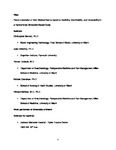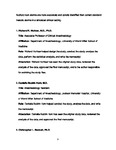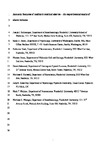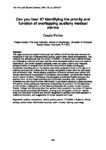Recommendation of New Medical Alarms based on Audibility, Identifiability, and Detectability in a Randomized, Simulation-Based Study
| dc.contributor.author | Edworthy, Judy | |
| dc.contributor.author | Bennett, C | |
| dc.contributor.author | Dudaryk, R | |
| dc.contributor.author | Crenshaw, N | |
| dc.contributor.author | McNeer, R | |
| dc.date.accessioned | 2019-05-02T08:11:39Z | |
| dc.date.issued | 2019-08 | |
| dc.identifier.issn | 0090-3493 | |
| dc.identifier.issn | 1530-0293 | |
| dc.identifier.uri | http://hdl.handle.net/10026.1/13762 | |
| dc.description.abstract |
<jats:sec> <jats:title>Objectives:</jats:title> <jats:p>Accurate and timely identification of existing audible medical alarms is not adequate in clinical settings. New alarms that are easily heard, quickly identifiable, and discernable from one another are indicated. The “auditory icons” (brief sounds that serve as metaphors for the events they represent) have been proposed as a replacement to the current international standard. The objective was to identify the best performing icons based on audibility and performance in a simulated clinical environment.</jats:p> </jats:sec> <jats:sec> <jats:title>Design:</jats:title> <jats:p>Three sets of icon alarms were designed using empirical methods. Subjects participated in a series of clinical simulation experiments that examined the audibility, identification accuracy, and response time of each of these icon alarms. A statistical model that combined the outcomes was used to rank the alarms in overall efficacy. We constructed the “best” and “worst” performing sets based on this ranking and prospectively validated these sets in a subsequent experiment with a new subject sample.</jats:p> </jats:sec> <jats:sec> <jats:title>Setting:</jats:title> <jats:p>Experiments were conducted in simulated ICU settings at the University of Miami.</jats:p> </jats:sec> <jats:sec> <jats:title>Subjects:</jats:title> <jats:p>Medical trainees were recruited from a convenience sample of nursing students and anesthesia residents at the institution.</jats:p> </jats:sec> <jats:sec> <jats:title>Interventions:</jats:title> <jats:p>In Experiment 1 (formative testing), subjects were exposed to one of the three sets of alarms; identical setting and instruments were used throughout. In Experiment 2 (summative testing), subjects were exposed to one of the two sets of alarms, assembled from the best and worst performing alarms from Experiment 1.</jats:p> </jats:sec> <jats:sec> <jats:title>Measurements and Main Results:</jats:title> <jats:p>For each alarm, we determined the minimum sound level to reach audibility threshold in the presence of background clinical noise, identification accuracy (percentage), and response time (seconds). We enrolled 123 medical trainees and professionals for participation (78 with < 6 yr of training). We identified the best performing icon alarms for each category, which matched or exceeded the other candidate alarms in identification accuracy and response time.</jats:p> </jats:sec> <jats:sec> <jats:title>Conclusions:</jats:title> <jats:p>We propose a set of eight auditory icon alarms that were selected through formative testing and validated through summative testing for adoption by relevant regulatory bodies and medical device manufacturers.</jats:p> </jats:sec> | |
| dc.format.extent | 1050-1057 | |
| dc.format.medium | ||
| dc.language | en | |
| dc.language.iso | en | |
| dc.publisher | Lippincott, Williams & Wilkins | |
| dc.subject | alarm fatigue | |
| dc.subject | audible alarms | |
| dc.subject | auditory alarms | |
| dc.subject | medical alarms | |
| dc.subject | patient monitoring | |
| dc.subject | simulation | |
| dc.title | Recommendation of New Medical Alarms based on Audibility, Identifiability, and Detectability in a Randomized, Simulation-Based Study | |
| dc.type | journal-article | |
| dc.type | Journal Article | |
| dc.type | Randomized Controlled Trial | |
| dc.type | Research Support, Non-U.S. Gov't | |
| plymouth.author-url | https://www.webofscience.com/api/gateway?GWVersion=2&SrcApp=PARTNER_APP&SrcAuth=LinksAMR&KeyUT=WOS:000475675500030&DestLinkType=FullRecord&DestApp=ALL_WOS&UsrCustomerID=11bb513d99f797142bcfeffcc58ea008 | |
| plymouth.issue | 8 | |
| plymouth.volume | 47 | |
| plymouth.publication-status | Published | |
| plymouth.journal | Critical Care Medicine | |
| dc.identifier.doi | 10.1097/CCM.0000000000003802 | |
| plymouth.organisational-group | /Plymouth | |
| plymouth.organisational-group | /Plymouth/Faculty of Health | |
| plymouth.organisational-group | /Plymouth/Research Groups | |
| plymouth.organisational-group | /Plymouth/Research Groups/Centre for Brain, Cognition and Behaviour (CBCB) | |
| plymouth.organisational-group | /Plymouth/Research Groups/Centre for Brain, Cognition and Behaviour (CBCB)/Behaviour | |
| plymouth.organisational-group | /Plymouth/Users by role | |
| dc.publisher.place | United States | |
| dcterms.dateAccepted | 2019-04-04 | |
| dc.rights.embargodate | 2020-7-31 | |
| dc.identifier.eissn | 1530-0293 | |
| dc.rights.embargoperiod | Not known | |
| rioxxterms.versionofrecord | 10.1097/CCM.0000000000003802 | |
| rioxxterms.licenseref.uri | http://www.rioxx.net/licenses/all-rights-reserved | |
| rioxxterms.licenseref.startdate | 2019-08 | |
| rioxxterms.type | Journal Article/Review |





